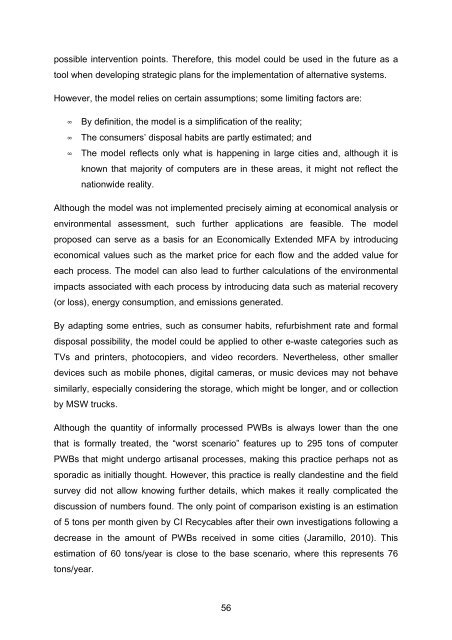10 07 29 Master thesis Juliana Leon - e-Waste. This guide
10 07 29 Master thesis Juliana Leon - e-Waste. This guide
10 07 29 Master thesis Juliana Leon - e-Waste. This guide
You also want an ePaper? Increase the reach of your titles
YUMPU automatically turns print PDFs into web optimized ePapers that Google loves.
possible intervention points. Therefore, this model could be used in the future as a<br />
tool when developing strategic plans for the implementation of alternative systems.<br />
However, the model relies on certain assumptions; some limiting factors are:<br />
• By definition, the model is a simplification of the reality;<br />
• The consumers’ disposal habits are partly estimated; and<br />
• The model reflects only what is happening in large cities and, although it is<br />
known that majority of computers are in these areas, it might not reflect the<br />
nationwide reality.<br />
Although the model was not implemented precisely aiming at economical analysis or<br />
environmental assessment, such further applications are feasible. The model<br />
proposed can serve as a basis for an Economically Extended MFA by introducing<br />
economical values such as the market price for each flow and the added value for<br />
each process. The model can also lead to further calculations of the environmental<br />
impacts associated with each process by introducing data such as material recovery<br />
(or loss), energy consumption, and emissions generated.<br />
By adapting some entries, such as consumer habits, refurbishment rate and formal<br />
disposal possibility, the model could be applied to other e-waste categories such as<br />
TVs and printers, photocopiers, and video recorders. Nevertheless, other smaller<br />
devices such as mobile phones, digital cameras, or music devices may not behave<br />
similarly, especially considering the storage, which might be longer, and or collection<br />
by MSW trucks.<br />
Although the quantity of informally processed PWBs is always lower than the one<br />
that is formally treated, the “worst scenario” features up to <strong>29</strong>5 tons of computer<br />
PWBs that might undergo artisanal processes, making this practice perhaps not as<br />
sporadic as initially thought. However, this practice is really clandestine and the field<br />
survey did not allow knowing further details, which makes it really complicated the<br />
discussion of numbers found. The only point of comparison existing is an estimation<br />
of 5 tons per month given by CI Recycables after their own investigations following a<br />
decrease in the amount of PWBs received in some cities (Jaramillo, 20<strong>10</strong>). <strong>This</strong><br />
estimation of 60 tons/year is close to the base scenario, where this represents 76<br />
tons/year.<br />
56
















